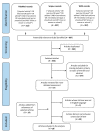Can Physical Activity Influence Human Gut Microbiota Composition Independently of Diet? A Systematic Review
- PMID: 34072834
- PMCID: PMC8228232
- DOI: 10.3390/nu13061890
Can Physical Activity Influence Human Gut Microbiota Composition Independently of Diet? A Systematic Review
Abstract
Evidence suggests that physical activity (PA) influences the human gut microbiota composition, but its role is unclear because of dietary interference. The aim of this review is to clarify this issue from this new perspective in healthy individuals. Articles analyzing intestinal microbiota from fecal samples by 16S rRNA amplicon sequencing were selected by searching the electronic databases PubMed, Scopus, and Web of Science until December 2020. For each study, methodological quality was assessed, and results about microbiota biodiversity indices, phylum and genus composition, and information on PA and diet were considered. From 997 potentially relevant articles, 10 met the inclusion criteria and were analyzed. Five studies involved athletes, three were performed on active people classified on the basis of habitual PA level, and two among sedentary subjects undergoing exercise interventions. The majority of the studies reported higher variability and prevalence of the phylum Firmicutes (genera Ruminococcaceae or Fecalibacteria) in active compared to inactive individuals, especially in athletes. The assessment of diet as a possible confounder of PA/exercise effects was completed only in four studies. They reported a similar abundance of Lachnospiraceae, Paraprevotellaceae, Ruminococcaceae, and Veillonellaceae, which are involved in metabolic, protective, structural, and histological functions. Further studies are needed to confirm these findings.
Keywords: biodiversity; diet; gut; healthy; human; microbiota; physical activity.
Conflict of interest statement
The authors declare no conflict of interest.
Figures


References
Publication types
MeSH terms
LinkOut - more resources
Full Text Sources
Medical
Miscellaneous

